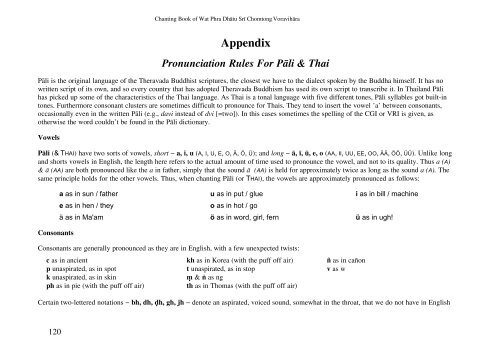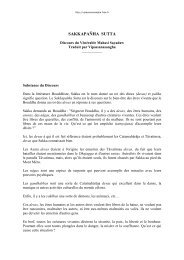Chomthong Chanting Book - Vipassanasangha - Free
Chomthong Chanting Book - Vipassanasangha - Free
Chomthong Chanting Book - Vipassanasangha - Free
Create successful ePaper yourself
Turn your PDF publications into a flip-book with our unique Google optimized e-Paper software.
<strong>Chanting</strong> <strong>Book</strong> of Wat Phra Dhātu Srī Chomtong Voravihāra<br />
Appendix<br />
Pronunciation Rules For Pāli & Thai<br />
Pāli is the original language of the Theravada Buddhist scriptures, the closest we have to the dialect spoken by the Buddha himself. It has no<br />
written script of its own, and so every country that has adopted Theravada Buddhism has used its own script to transcribe it. In Thailand Pāli<br />
has picked up some of the characteristics of the Thai language. As Thai is a tonal language with five different tones, Pāli syllables got built-in<br />
tones. Furthermore consonant clusters are sometimes difficult to pronounce for Thais. They tend to insert the vowel ’a’ between consonants,<br />
occasionally even in the written Pāli (e.g., davi instead of dvi [=two]). In this cases sometimes the spelling of the CGI or VRI is given, as<br />
otherwise the word couldn’t be found in the Pāli dictionary.<br />
Vowels<br />
Pāli (& THAI) have two sorts of vowels, short − a, i, u (A, I, U, E, O, Ä, Ö, Ü); and long − ā, ī, ū, e, o (AA, II, UU, EE, OO, ÄÄ, ÖÖ, ÜÜ). Unlike long<br />
and shorts vowels in English, the length here refers to the actual amount of time used to pronounce the vowel, and not to its quality. Thus a (A)<br />
& ā (AA) are both pronounced like the a in father, simply that the sound ā (AA) is held for approximately twice as long as the sound a (A). The<br />
same principle holds for the other vowels. Thus, when chanting Pāli (or THAI), the vowels are approximately pronounced as follows:<br />
Consonants<br />
a as in sun / father u as in put / glue i as in bill / machine<br />
e as in hen / they o as in hot / go<br />
ä as in Ma'am ö as in word, girl, fern ü as in ugh!<br />
Consonants are generally pronounced as they are in English, with a few unexpected twists:<br />
c as in ancient<br />
p unaspirated, as in spot<br />
k unaspirated, as in skin<br />
ph as in pie (with the puff off air)<br />
kh as in Korea (with the puff off air)<br />
t unaspirated, as in stop<br />
ü & ï as ng<br />
th as in Thomas (with the puff off air)<br />
ñ as in cañon<br />
v as w<br />
Certain two-lettered notations − bh, dh, óh, gh, jh − denote an aspirated, voiced sound, somewhat in the throat, that we do not have in English<br />
120



